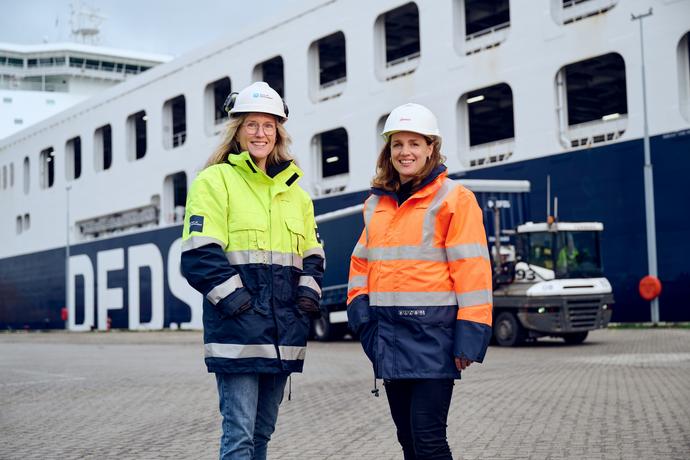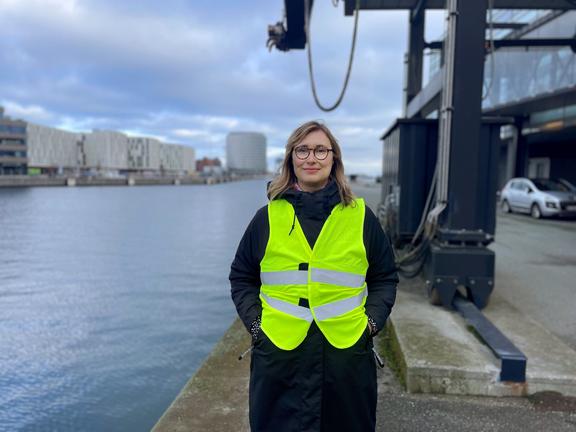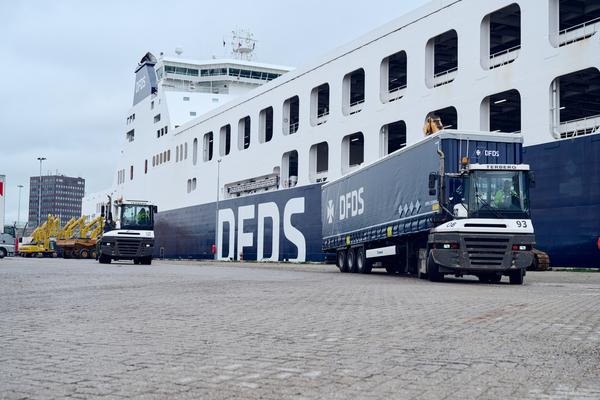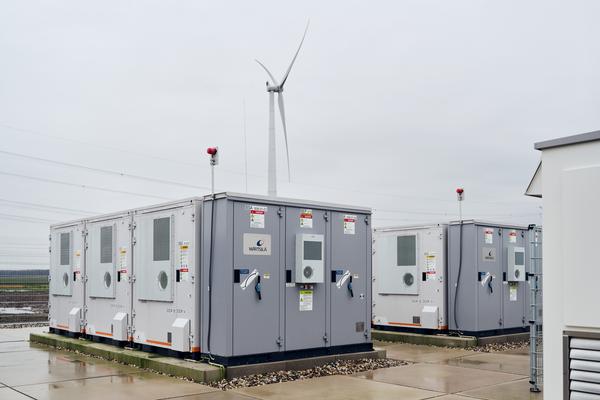
More and more ships plug into shore power for green energy
From late 2023 onwards, some of DFDS’ ships moored at one of the berths in Vlaardingen, the Netherlands, will be supplied with green power from a shore-power unit. The ships will not need to use their diesel engines when they are moored anymore. ‘Shore power can help reduce CO₂ emissions drastically and improve our living conditions in the coming years.’
Even when a ship is moored in port, it still needs power so the crew can continue with their work. ‘It also needs electricity to cool its cargo, if it’s things like oranges, stored in the containers’, Floor Schipper explains (top photograph, on the left of the picture). Schipper works for the Port of Rotterdam Authority and is in charge of the team engaged in scaling up, and accelerating, the use of shore power in the port of Rotterdam. The Port of Rotterdam Authority works closely with energy company Eneco to supply that shore power.
Even when a ship is moored in port, it still needs power so the crew can continue with their work. ‘It also needs electricity to cool its cargo, if it’s things like oranges, stored in the containers’, Floor Schipper explains (top photograph, on the left of the picture). Schipper works for the Port of Rotterdam Authority and is in charge of the team engaged in scaling up, and accelerating, the use of shore power in the port of Rotterdam. The Port of Rotterdam Authority works closely with energy company Eneco to supply that shore power.
A drop in CO₂ emissions thanks to shore power
At the moment, that energy is generated by the diesel engines on DFDS’ ships. However, the engines harm the environment and pollute the immediate surroundings with greenhouse gases, nitrogen, particulates and – at times – noise. All that will be a thing of the past once the ships switch to green power sourced from the sun and the wind and supplied by a shore-power unit when they are moored.Shore power, which is what we call the ‘electricity from a plug on the quay’, is a major part of the energy transition in our ports. ‘Ships can switch off their engines when they plug into shore power, cutting back practically all emissions”, Schipper continues.
When, in a short while, the freight ferries belonging to DFDS, Northern Europe’s largest short-distance shipping company, are plugged into the shore-power connection, CO₂ emissions will drop by about 2,100 tonnes per ship per year. That number can be compared to the average annual emissions produced by more than 11,000 households (Source: Milieu Centraal).
Promoting shore power
The Port of Rotterdam Authority and Eneco share some ambitious climate goals and want to encourage ships to switch to shore power, which is why they set up a subsidiary, Rotterdam Shore Power, in 2019. In early 2022, this partnership commissioned Europe’s largest shore-power unit for Heerema’s floating cranes in the port of Rotterdam, and now work has started on a unit for Boskalis’ working vessels in the port’s Waalhaven.The DFDS moorings in Vlaardingen will soon be the third location in the port to supply shore power, thanks to Rotterdam Shore Power. First of all, shore-power units will be installed for the moorings for the Jinling roll-on-roll-off freight ferries, with the other two DFDS moorings in Vlaardingen following later.
Two thousand metres of cables
A shore power unit requires a lot more work than you would suppose. ‘You can’t just plug a large freight ferry into the grid,’ explains Johanna von der Decken, DFDS’ Senior Category Manager (pictured below). ‘The ships need to be ready for shore power too: to use power from an external source, both the ships and the port need major adjustments’, adds Von der Decken.
‘And it’s quite a challenge to make those adjustments. For starters, we need two thousand metres of cables for the ships’, Von der Decken continues. Nonetheless, DFDS is pleased with the investments in the shore-power project because it is a step closer to their goal of climate neutrality in 2050. ‘We regard it as a chance to contribute to the maritime transport sector’s transition to green energy’, Von der Decken explains.
A lot of work needs to be done before the shore-power unit can be commissioned. ‘Fine-tuning a shore-power unit requires a tailored approach. First of all, we need to coordinate the supply and the demand for electricity. To get that right, it’s crucial to work together closely’, says Jiska Schimmelpennink, Renewable Energy Solutions Project Manager at Eneco (top photograph, right-hand side). ‘The shore-power capacity needs to match DFDS’ freight ferries’ need for electricity exactly. And we have to carry out all the work while everybody in the port goes about their daily business. So we can’t close shop, so to speak, while we do the work.’
A lot of work needs to be done before the shore-power unit can be commissioned. ‘Fine-tuning a shore-power unit requires a tailored approach. First of all, we need to coordinate the supply and the demand for electricity. To get that right, it’s crucial to work together closely’, says Jiska Schimmelpennink, Renewable Energy Solutions Project Manager at Eneco (top photograph, right-hand side). ‘The shore-power capacity needs to match DFDS’ freight ferries’ need for electricity exactly. And we have to carry out all the work while everybody in the port goes about their daily business. So we can’t close shop, so to speak, while we do the work.’
Shipping has a major part in climate goals
It is extremely important that the shipping industry becomes more sustainable, because more than 80 per cent of the world’s goods are transported by sea (Source: Unctad). It’s not surprising then, that shore power has a major part in achieving the European climate goals. The European Parliament is making it compulsory for large container ships and passenger ships (cruise ships and ferries) to use shore power from 2030 onwards.‘So, when the Port of Rotterdam Authority and Eneco launched Rotterdam Shore Power three years ago, we were ahead of the legislation. And that just goes to show that we set ourselves ambitious targets’, Schipper and Schimmelpennink say with pride. ‘The great advantage of shore power is that it can already help reduce CO₂ emissions and improve our living conditions in the coming years.’
This article was written by NU.nl’s commercial editorial team.

